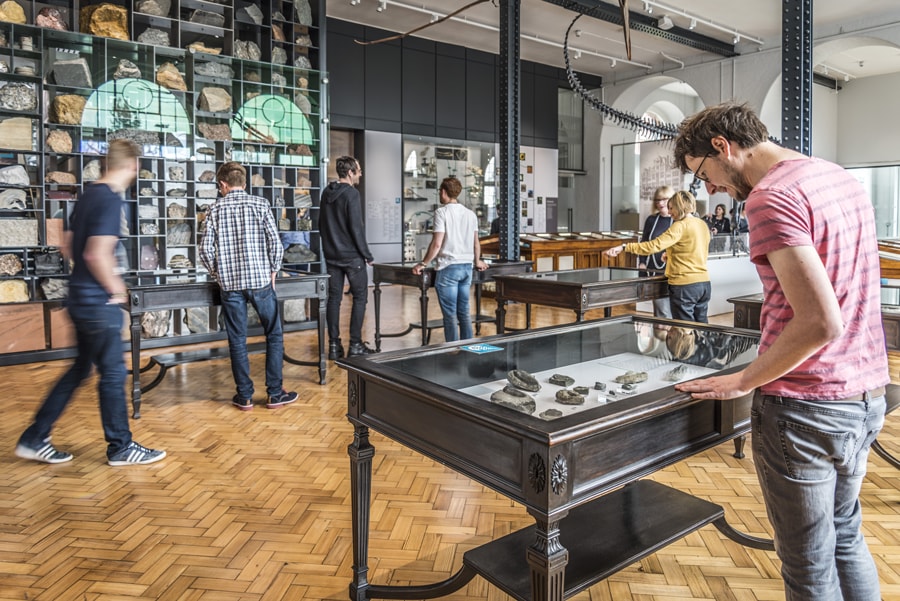
Art Fund this evening (Thursday 27 April 2017) announced Birmingham’s Lapworth Museum of Geology among the five museums which have been selected as finalists for Art Fund Museum of the Year 2017, the world’s largest and most prestigious prize for museums.
The University of Birmingham’s Lapworth museum is home to one of the UK’s most outstanding geological collections, with the finest array of fossils, rocks and minerals in the Midlands. Last year saw a significant leap forward for the Lapworth, which received a transformational £2.7million regeneration and redevelopment to make the former academic museum accessible to thousands of new visitors.
The shortlist announcement was made by Stephen Deuchar, Art Fund’s Director, at an event at the British Museum. It was followed by a discussion about the role of museums with Hartwig Fischer, Director of the British Museum, member of the 2017 jury; Tristram Hunt, Director of the Victoria and Albert Museum, Art Fund Museum of the Year 2016; and Sarah Munro, Director of the Baltic Centre for Contemporary Art.
The other museum finalists are: The National Heritage Centre for Horseracing & Sporting Art, Newmarket; Sir John Soane’s Museum, London; Tate Modern, London; and The Hepworth Wakefield.
The winning museum, which will receive £100,000, will be announced at a ceremony at the British Museum on Wednesday 5 July 2017. In addition, for the first time this year, the other shortlisted museums will receive £10,000 each in recognition of their achievements. This year’s jury, chaired by Dr Stephen Deuchar CBE, comprises: Professor Richard Deacon CBE; Dr Hartwig Fischer; Munira Mirza; and Jo Whiley.
Jon Clatworthy, Director of the Lapworth Museum of Geology, said: "We are absolutely delighted to receive this important recognition. The last year has been truly transformative, propelling the museum into the 21st century and making it accessible to a diverse new audience. The renovation of the space combined with a focus on digital technologies and interactive displays significantly enhances our public engagement and schools outreach with important scientific collections to help bring the story of evolution to life. Our visitors can now walk through time and gain unique insight into 4.5 billion years of history.
"We believe that this interface between academic research in geology and the general public is truly unique: our academic researchers are pioneering, working as part of international teams to make new discoveries and develop our understanding of evolution. We look forward to welcoming more and more visitors to showcase the fantastic collections of fossils and minerals and inspire a new generation of scientists!"
Speaking on behalf of the jury, Stephen Deuchar said: "Each of these museums has had a remarkable year, reaching - in a range of ways - new heights in their efforts to serve and inspire their visitors. Whether unveiling new buildings, galleries, displays or public programmes, all the finalists have shown a real commitment to innovation and experimentation, offering fresh perspectives and news ways of seeing and understanding their collections."
For more information, please contact Samantha Williams, University of Birmingham, +44 (0) 121 414 3984 | +44 (0) 7812671797
Dating back to 1880, The Lapworth Museum of Geology is one of the leading geological museums in the UK, with the largest collection of its kind in the Midlands. The museum re-opened in June 2016 after a £2.7 million redevelopment and expansion which transformed an academic university museum into a major new public attraction for Birmingham and beyond. It has helped bring to life internationally-significant scientific collections of over 250,000 specimens, ranging from dinosaur skeletons to volcanic rocks. The Museum’s core is now restored to its original 1920s grandeur and three new galleries have been unveiled, while beautifully designed, interactive displays and new visitor facilities have been created, including a state-of-the-art education room. Since re-opening, the museum has expanded its volunteer programme, diversified its audiences and education offering, and doubled visitor numbers.
Art Fund is the national fundraising charity for art. In the past five years alone Art Fund has given £34 million to help museums and galleries acquire works of art for their collections. It works with over 700 museums and galleries across the UK and helps museums share their collections with wider audiences by supporting a range of tours and exhibitions, including ARTIST ROOMS, and makes additional grants to support the training and professional development of curators.
Art Fund is independently funded, with the core of its income provided by 123,000 members who receive the National Art Pass and enjoy free entry to over 240 museums, galleries and historic places across the UK, as well as 50% off entry to major exhibitions. In addition to grant-giving, Art Fund’s support for museums includes the annual Art Fund Museum of the Year, a publications programme and a range of digital platforms.
Art Fund has supported Museum of the Year since 2008. Its forerunner was the Prize for Museums and Galleries, administered by the Museum Prize Trust and sponsored by the Calouste Gulbenkian Foundation from 2003-2007. The prize champions what museums do, encourages more people to visit and gets to the heart of what makes a truly outstanding museum. The judges present the prize to the museum or gallery that has best met some or all of the following criteria:
- Undertaken projects that will provide a lasting legacy or have a transformative effect on the museum
- Brought its collections to life for audiences in exceptional ways – engaging, inspiring and extending public understanding
- Delivered an innovative programme of audience development, learning or outreach
- Clearly won the support and enthusiasm of its visitors and users.
Winners over the past six years were the V&A (2016), The Whitworth (2015), Yorkshire Sculpture Park (2014), William Morris Gallery (2013), Royal Albert Memorial Museum (2012) and the British Museum (2011).